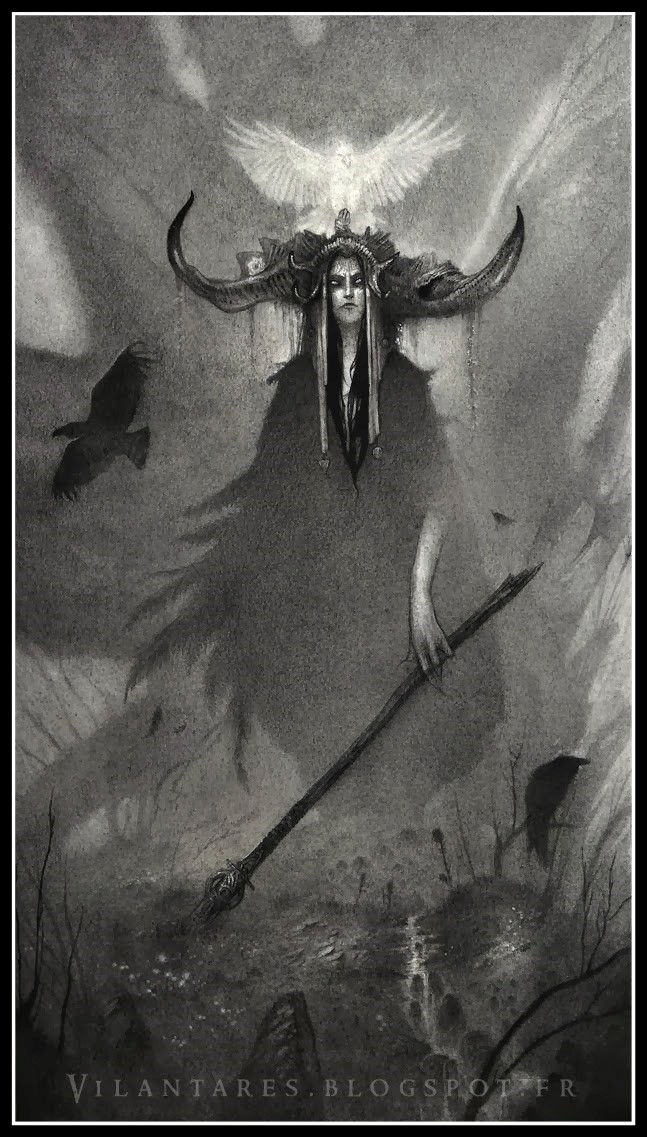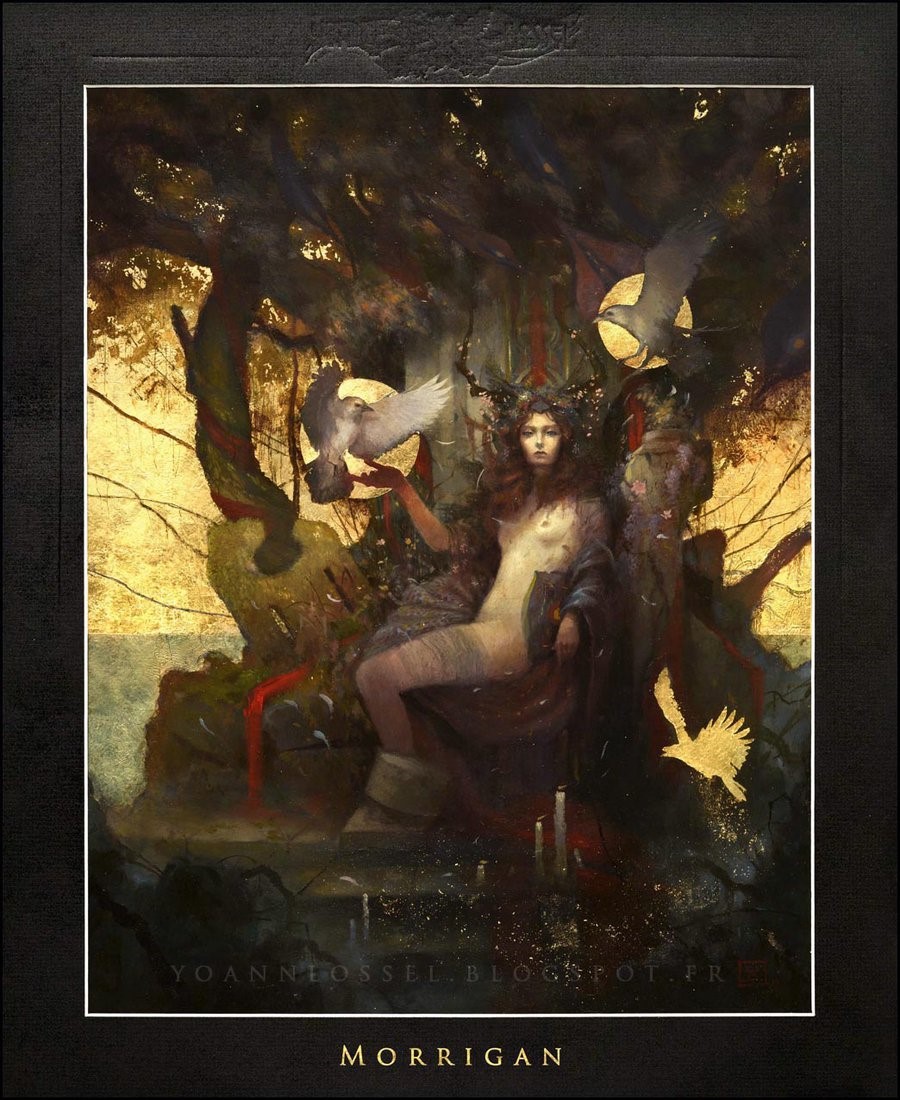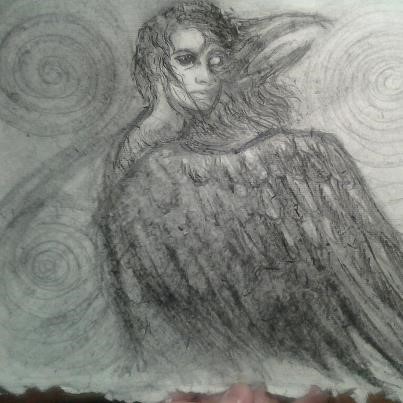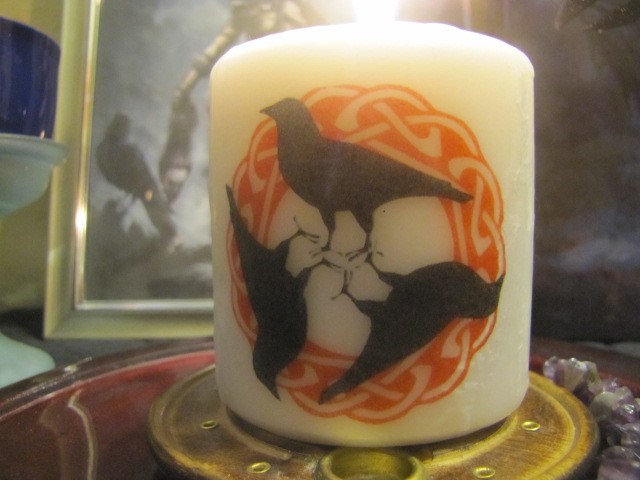The
Morrigan

Morrigan
is one of the great Goddesses of Ireland and is a multifaceted
Goddess. She is one as Morrigan and many, a trinity as “The Morrigan or
the
“Morrigu”. She is a shape shifter known for being a Goddess of war and
battle, the
cycle of life and death, and is also associated with wisdom and
prophecy, magick
and the land, among other aspects.
Culture and Origins:
To
truly gain a more insightful understanding of who
Morrigan is, it is important to understand Celtic culture of that era.
The
Celts idolized warfare, and women were warriors up until 697 CE, often
fighting
in battle or helping the wounded. Protecting their families and their
land (viewed
as female) was a dominant aspect of the Celts pride and was reflected
in the
Morrigan.
Morrigan
first appears in The Lebor Gabala Erenn (The Book of
Invasions), dating back to 1150
CE, and is a pseudo-narrative of the history of Ireland that includes
the
arrival of the Celtic gods, the Tuatha De Danann, in Ireland and their
later battle
with the indigenous gods, the Fir Blogs. Interestingly, these stories
were not
recorded by the Irish Pagans. Celtic culture prized oral tradition and
memorization, as it was an art form of storytelling. It was the Irish
Christian
monks, who were their descendants that preserved what they believed to
be
historical account.
Morrigan’s
origins can be traced
back to the Copper age megalithic Cult of the Mothers (Matrones,
Idises, Disit,
etc.) whom appeared as triple Goddesses from narrative texts written by
Irish
monks sometime between the eighth and twelfth centuries, after
Christianity had
replaced Paganism as the dominant religion in Ireland.
Morrigan’s
connection to battle and why Morrigan was
important to the Celts and their culture becomes evident in these
texts,
although that is not all she represents. Morrigan’s name in history has
varying
spellings and translations, but in Irish her name was originally
Mor-Rioghain,
meaning “great queen” or “phantom queen”. The word “Rigan”, translates
to
“queen” and although “Mor” has several translations, “great” is the
most
accredited and accurate meaning to Morrigan. This meaning connects her
to
sovereignty as she was very much revered.
The
Morrigan

It
was common in Celtic culture for a Goddess to be conveyed
in different forms or attributes to further illustrate her qualities.
The
Morrigan or the Morrigu was a triad of Goddesses, sometimes depicted as
sisters
and at times interchangeable. The Morrigan included Badb, Macha, Neiman
and occasionally
Anu (whom might have been the crone aspect of Badb). Furthermore,
depending on
the text, Badb and Macha and Nemain might have been the same entity.
However, I
have included some aspects of each for clarity.
Badb: A war
Goddess associated with battle, destruction, and death and often
appeared over
battle as a hooded crow, or ran alongside warriors disguised as a
grey-red wolf.
Badb was connected to rebirth as a watcher of the cauldron of
regeneration in
the Otherworld. She was also a Witch and a sorceress, and a Prophetess
who foresaw
the future.
Macha: The root
word “mag” translated means field, plain or pasture. This name connects
and
gives Macha power over the sacred land and horses, representing wealth,
power and
symbolizing the elite warriors. She was also connected to fertility by
the land
and horses, and cursed the male Red Branch warrior to suffer nine days
of birth
pangs when forced to run a race. As part of the trinity, she rained
down fire
and blood on her enemies.
Nemain: Her name
translates to panic, frenzy or venomous. Also a deity of battle, death
and
destruction, she appeared as a carrion crow. Neiman was a prophetess
and her
battle cries meant death would soon follow. By shrieking furiously, she
intimidated, panicked and confused soldiers on the battle field into
dying of
fright or mistaking their own comrades for enemies. This aspect
connects to the
role of Banshee.
Legend of
Morrigan
There
are various stories of Morrigan, some are
contradictory or change depending on the source. However, The Morrigan
is first
seen in the Battle of Moytura between a race of Gods called the Tuatha
De
Dannon (who invaded Ireland) and their followers and the indigenous Fir
Bolgs. Before
the battle erupts, the Morrigan cries out doom and uses sorcery against
the
Tuatha De Dannon to rain down fire and blood so that they could not
move for
three days and nights.
In
the Ulster Cycle, Táin Bó Regamna (The Cattle Raid of
Regamain), which is a body of Irish mythology, Morrigan appears to the
hero
Cuchulainn (whom she has appeared to in different guises) and he finds
her
stealing one of his cows, yet he does not recognize her and becomes
angry and
insults her. Shape-shifting into a crow, he now recognizes her and
acknowledges
he would not have insulted her had he known, yet she prophesizes his
death in
battle which came to pass.
Morrigan
also appears to Cuchulainn as a young woman (or
hag, depending on the version) and offers him her love, and her aid in
the
battle, but he rejects her offer. In response she intervenes in his
next
combat, first in the form of an eel who trips him, then as a wolf who
stampedes
cattle across the ford, and finally as a white, red-eared heifer
leading the
stampede, just as she had warned in their previous encounter.
In
the Cath Maige Tuireadh, on Samhain Morrigan has an
encounter with the Dagda (High King of the Tuatha De Dannan) before the
battle
against the Fomorians. When he meets her she is washing battle clothes
while standing
with one foot on either side of the river Unius and they mate. She then
promises to summon the magicians of Ireland to cast spells on behalf of
the
Tuatha De Dannan and to destroy Indech, the Fomorian king.
Battlefield and
Transformations

Morrigan
was clearly a Goddess who embodied a strong woman
and the Celtic love of warfare. She used spells and incantations
(magick and
sorcery) as her main weapon, yet, she is also said to have fought
alongside the
battlefield. In earlier Celtic accounts, she her head was that of a
crow,
raven, or vulture, although she has transformed into a white cow with
red ears,
an eel, an old hag and a young woman. She was also known as Caileach
(crone)
who granted sovereignty or took it away from kings.
Goddess
Associations
and Lineage:
Although
speculated, Morrigan may have been the daughter of
Delbaeth and Ernmas whom in the earliest copies of the Lebor Gabala
Erenn (The
Book of Invasions) had three daughters, named Badb, Macha, and Anand.
In the
Book of Leinster, Anand is also known as Morrigu, while in the Book of
Fermoy
version, Macha is identified with Morrigan. In addition, Morrigan may
had been
one of Dagda’s wives and had sons.
It
is said that she was one of the Tuatha de Danann (The
tribe of the Goddess Danu). Her origins do seem to stem from the
megalithic
cult of the Mothers (Matrones, Idises, Disir) who were triple Goddesses
expressed through battle and re-birth. There are no known Goddesses
associated
with her directly, except perhaps Morgan Le Fey, yet, apart from the
name, most
scholars are at odds with this assumption.
There
is no actual evidence of how Morrigan was worshipped
in her time. However, because she was associated with Samhain it is
thought
that her biggest devotions came at this time. Most of her worship may
have been
on the battlefields before, during, or after warfare as well.
There
are several sites associated with the Goddess Morrigan
in Northern Ireland. One such place is a county town known as Armagh
which
translates as “Macha’s height” or Machas’s high place. The Dá
Chich na Morrigna
("two breasts of the Morrigan"), a pair of hills in Co. Armgh, which
was considered the capital on Ulster in the chronicles of the Ulster
Cycle. In
the county of Louth, there is a field known as Gort na Morrighan
(Morrigan’s
field), which was said to be given to her by the Dagda. Boa Island, the
largest
island in Northern Island hbbis named after Badb. In addition,
inscriptions
invoking Cahaboduva (battle Raven) han mve been found in
the Drome region of
France.
Associations:
Weapons: spears, swords,
sorcery, shield, shape-shifting
Other:
death, re-birth, the cycle of life, fate, battle,
skulls, blood, prophecy, sovereignty, land
Animals:
Scavenger birds, i.e. crows, ravens, vultures,
eels, wolves, cows and horses
Colors:
red and black, white, purple, and dark blue
Stones:
Obsidian, Rubies, jet, Amethyst, Garnet, bloodstone,
Clear Quartz
Symbols:
Three interlinking lines or inverted triangle
Herbs
and plants: Blackthorn, Belladonna, Juniper berries, Nightshade,
Dragon’s blood, Mugwart, Yew
Moon
phase: New, dark, waning
Regions:
Fords, rivers, lakes
Seasons:
Autumn, specifically Samhain
Foods:
Mead, milk, whiskey, apple, water, red colored foods
Colors:
red and black
Elements:
Fire and water
Festivals: Jan 7-The
Feast of Morrigan
Folksongs:
Celtic nursery rhymes and folksongs referring to
three black birds or ravens

Lessons from the Morrigan
Although
it appears that Morrigan teaches us how to fight on
the battlefield, if one looks as life as a battlefield, there is much
more to
learn. She challenges, tests, and encourages us to take action in our
lives, to
become stronger, to create change, to release what no longer benefits
us, to
fight for what we believe in and stand up for ourselves; to point out
the
truth, to change our fate or accept it, and to use our own power as
Goddesses.
She is a woman of influence, and although we cannot physically
transform
ourselves into other forms, we can in numerous other ways. This is a
lesson
anyone can learn.
As
Penczak observes, “The battle to control, change and
master the self is as much a part of their magick as is the battle to
change
outer conditions in the world” (Feast of the Morrighan: A Grimoire for
the Dark
Lady of the Emerald Isle).

Morrigan
Ritual
Warrior
Woman Ritual with the Morrigan (The Goddess
Connections Workbook)
As
the Goddess of Battle, The Morrigan teaches us to protect
what we hold dear and fight for what we think is right. She directs us
towards
change, and helps us to confront our inner demons in order to overcome
the
battles in our lives. In this exercise you will reclaim your inner
warrior
woman, and ask The Morrigan to help you to fight with passion and
strength.
On
a piece of paper, write down what it is you need to be
strong or, stand up for, protect, whatever you need to invoke The
Warrior
Goddess power for. This ritual should be performed on the waning moon.
Items Needed:
One red chime
candle
Fireproof
dish/cauldron
Anthame/knife
Black obsidian
stone
Small
goblet/glass of red wine
Incense of dragon
blood mixed with juniper berries
Now
set up your altar how you with and cleanse yourself and
your space as you normally would. Take a few deep breaths in and out to
center
yourself. Light your candle and incense, and take your black obsidian
in your
hand. Make sure your paper with your wish from the Warrior Goddess is
near. Now
invoke The Morrigan while holding your black obsidian stone over the
candle
flame:
Dark Mistress of
Battle and Strife
I invoke your id
on
this waning moon night,
Lend me your
strength
to end my battle within
Empower me Great
Goddess help me to win
Ancient Woman, I
hear
your battle cry,
Help
me to be rid of these
negativities tonight!
Now
read what you wrote on your paper, and place your
obsidian back on the altar. Take your anthame and make an X over the
paper,
burn it in the candle flame, and throw it in the fireproof dish. Watch
it burn
and imagine your problem dissipating like the smoke. Meditate for a few
minutes. Then take your goblet of red wine, hold it up and thank The
Morrigan
for her help. Now take a sip and place it back on your altar. Open your
circle
and ground. Let your candle burn down completely. Take your wine
outside and
pour in onto the earth as your offering. Keep your obsidian stone in
your
pocket, or near you when you need strength of The Morrigan. Make sure
you
record everything in your journal and bury the ashes from your paper
outside.
Works Cited:
Artisson,
Robin. The
Flaming Circle. Sunland: Pendraig Pubishing, 2008. Web. http://books.google.com/books?id=AhE8HswvXLEC&pg=PT88&dq=morrigan&hl=en&sa=X&ei=ySmEU4rtO4qBogSxqYFA&ved=0CDUQ6AEwAjgK#v=onepage&q=morrigan&f=false
Edain
McCoy. Celtic
Myth and Magic: Harness the power of the Gods and Goddesses. St.
Paul:
Llewellyn Publications, 2008. Print
Edain
McCoy. Celtic
Women’s Spirituality: Accessing the Cauldron of Life. St Paul:
Llewellyn
Publications., 1998. Print
Myers,
Brenden Cathbad. The
Mystery of Druidry: Celtic Mysticism, Theory and Practice. Franklin
Lake:
Career Press, 2006. Web. http://books.google.com/books?id=frz_DhB4CC8C&pg=PA66&dq=morrigan&hl=en&sa=X&ei=ySmEU4rtO4qBogSxqYFA&ved=0CC8Q6AEwATgK#v=onepage&q=morrigan&f=false
Monaghan,
Patricia. PhD. Encyclopedia
of Goddesses and Heroines. Novato: New World Library. 2014. Print.
Penczak,
Christopher. 2012). E—book. Feast of the Morrighan: A
grimoire for the Dark Lady of the Emerald Isle.
U.S.A.: Copper Cauldron Publishing, 2012. Kindle file.
Rankine,
David, & D’Este. The Guises of the Morrigan. Irish
Goddess of Sex & Battle: Her
Myths, Powers & Mysteries. England: Avalonia Books Publishing,
2005. Kindle
file.
Reynolds,
Tara. The
Morrigan: Goddess Connections Workbook. 2013. Kindle file
Rolleston,
T. Chapter III: The Irish Invasion Myths. Myths and
Legends of the Celtic Race.
1911. Internet sacred text archive.
2011. Web. http://www.sacred-texts.com/neu/celt/mlcr/mlcr03.htm
Woodfield,
Stephanie. Celtic
Lore & Spellcraft of the Dark Goddess. Invoking
the Morrigan. Woodbury: Llewellyn Publications, 2011. Web.
http://books.google.com/books?id=CRN4w6g2mMwC&printsec=frontcover&dq=morrigan&hl=en&sa=X&ei=BCmEU6f3N8-IogTcq4D4Bw&ved=0CD8Q6AEwAw#v=onepage&q=morrigan&f=false
Artwork:
With Permission
Laura
Cameron. “Morrigan” and “Raven Spirit” http://www.lauracameron.net/
Olivier
Villoingt. “The Soul of War” and “Morrigan” http://vilantares.blogspot.fr/
Yoann
Lossel. “La Morrigan” http://yoannlossel.blogspot.com/
Original Art: Altar dedicated to
Morrigan. Morrigan’s
symbols, such as fire, scavenger birds, feathers, Amethyst and clear
quartz, Mugwart,
skulls, a cauldron, colors red and black, her images and a sculpture. I
made
the candle with a symbol representing Morrigan to add to my altar.

